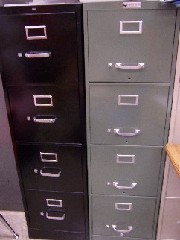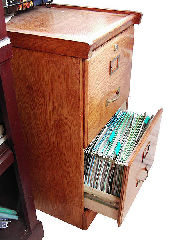Filing cabinet

A filing cabinet (or file cabinet in the United States) is a piece of office equipment that is useful for temporary and permanent storage. It is usually used for the storage of paper in a file folder. The two most common forms of filing cabinets are lateral files and vertical files.
A vertical file has drawers that extend from the short side (typically 15 inches)of the cabinet. A lateral file has drawers that extend from the long side (various lengths) of the cabinet. These are also called side filers in Great Britain.
Horizontal file
Henry Brown, an African American inventor, patented a "receptacle for storing and preserving papers" on November 2, 1886. This was a fire and accident safe container made of forged metal, which could be sealed with a lock and key. It was special in that it kept the papers separated.
Vertical file

The vertical filing cabinet (vertical file cabinet in the United States) more or less as in use today was invented by Edwin G. Seibels in 1898.[1] He was working in his father's insurance office and realized that the then current system of folding papers into envelopes and storing them in pigeon holes could be improved if the folding was dispensed with. The documents could then be stored in large envelopes (hangfiles) vertically, in drawers.
The use of filing cabinets was greatly expanded as a result of the commercial distribution of Xerography machines starting in 1950. This event enabled office workers to "have their own copy" of printed materials. Another influence is the expansion of government regulations that require businesses to create and keep forms and other documents. Some prognosticators have suggested the future of the filing cabinet is in doubt as electronic filing systems proliferate and become lower in cost. Nevertheless, most businesses are still purchasing computer systems with printing capabilities. Unless this trend is reversed, filing of paper is still a viable practice.
In the US, these come in two sizes: for letter-size paper and legal-size paper. Most modern commercially-oriented vertical filing cabinets in the US are manufactured in two, three, four, and five drawer versions in depths of 25, 26 1/2, and 28 inches. The drawers are typically supported on a three-member suspension system that allows the drawer to be fully extended for complete access.
The four drawer vertical file, letter width, is the version purchased by most businesses. The two drawer file is sold mostly for use alongside a desk. The five drawer file is mostly purchased by Federal, State, and Local governments (in a 28 inch deep version) as it typically provides the lowest cost per filing inch. Three drawer files, the least popular version, have the advantage of being at "countertop" height so end users can easily retrieve files and use the top of the cabinet as a work area to examine file contents.
The drawers of most vertical filing cabinets are engineered to accept hanging file folders as these have come to dominate the way most users store information. Some files still have a "follower block" in each drawer. This is a device that adjusts the apparent depth of the drawer interior so that files are kept upright in the drawer. These are the legacy of a time when most filing was done with manila folders rather than hanging files.
For home offices or lighter use applications, vertical files are manufactured in 18 inch deep versions. These typically have two-member suspensions and the drawers do not fully extend.
Lateral file
Lateral files are typically 20 inches deep and manufactured in 30, 36, and 42 inch widths and 2, 3, 4, and 5 drawer versions. The 30 inch wide, 2 drawer version is popular for use inside cubicle workstations as it is engineered to fit under or alongside the cubicle work surfaces. Logic for the use of 3, 4, and 5 drawer files is similar to that of vertical files. Unlike vertical files, most lateral files allow for side-to-side or front-to-back filing.
For letter size files arranged front-to-back, the 30 and 42 wide files are the most effective as the maximum amount of filing per cabinet is enabled. A 36 inch wide file, with letter width filing front-to-back has no more capacity than a corresponding 30 inch wide file.
Some users prefer side to side filing, as they can search index tabs from a seated position. All width lateral files can accommodate this configuration, though the capacity of the file is somewhat diminished.
An advantage for lateral files is that access and view of all files can be easier than with a vertical file because the drawers do not extend as far.
Filing outside the US
Foreign firms offer filing cabinets that permit A4 paper to be used in addition to letter-size. Double file cabinets whose drawers each can accommodate two racks for folders side by side.
Many European companies engineer filing systems that accommodate hanging folders only; there are no drawer bottoms. In the US, most file drawers still have bottoms in the drawers so materials of any sort can be stored.
UK file cabinets are slightly different from US in the width of the rails which support the suspension files, the US ones being narrower; the UK sizes are known as A4, foolscap and A3.








1 komentar:
As important as filing cabinets are, I believe they are becoming outdated as people are moving important information to external computer software servers.
Posting Komentar